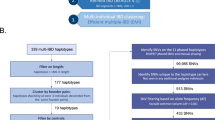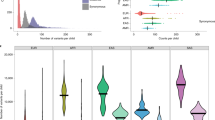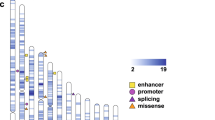Abstract
A genome scan was previously performed and pointed to chromosome 6q21 as a candidate region for autism. This region contains the glutamate receptor 6 (GluR6 or GRIK2) gene, a functional candidate for the syndrome. Glutamate is the principal excitatory neurotransmitter in the brain and is directly involved in cognitive functions such as memory and learning. We used two different approaches, the affected sib-pair (ASP) method and the transmission disequilibrium test (TDT), to investigate the linkage and association between GluR6 and autism. The ASP method, conducted with additional markers on the 51 original families and in eight new sibling pairs, showed a significant excess of allele sharing, generating an elevated multipoint maximum LOD score (ASPEX MLS = 3.28). TDT analysis, performed in the ASP families and in an independent data set of 107 parent-offspring trios, indicated a significant maternal transmission disequilibrium (TDTall P = 0.0004). Furthermore, TDT analysis (with only one affected proband per family) showed significant association between GluR6 and autism (TDT association P = 0.008). In contrast to maternal transmission, paternal transmission of GluR6 alleles was as expected in the absence of linkage, suggesting a maternal effect such as imprinting. Mutation screening was performed in 33 affected individuals, revealing several nucleotide polymorphisms (SNPs), including one amino acid change (M867I) in a highly conserved domain of the intracytoplasmic C-terminal region of the protein. This change is found in 8% of the autistic subjects and in 4% of the control population and seems to be more maternally transmitted than expected to autistic males (P = 0.007). Taken together, these data suggest that GluR6 is in linkage disequilibrium with autism.
This is a preview of subscription content, access via your institution
Access options
Subscribe to this journal
Receive 12 print issues and online access
$259.00 per year
only $21.58 per issue
Buy this article
- Purchase on Springer Link
- Instant access to full article PDF
Prices may be subject to local taxes which are calculated during checkout



Similar content being viewed by others
References
Kanner L . Autistic disturbances of affective contact Nerv Child 1943 2: 217–250
American Psychiatric Association. Diagnostic and Statistical Manual of Mental Disorders, 4th edn American Psychiatric Press: Washington DC 1994
Gillberg C, Wing L . Autism: not an extremely rare disorder Acta Psychiatr Scand 1999 99: 399–406
Miles JH, Hillman RE . Value of a clinical morphology examination in autism Am J Med Genet 2000 91: 245–253
Ritvo ER, Jorde LB, Mason-Brothers A, Freeman BJ, Pingree C, Jones MB et al. The UCLA-University of Utah epidemiologic survey of autism: recurrence risk estimates and genetic counseling Am J Psychiatry 1989 146: 1032–1036
Steffenburg S, Gillberg C, Hellgren L, Andersson L, Gillberg IC, Jakobsson G et al. A twin study of autism in Denmark, Finland, Iceland, Norway and Sweden J Child Psychol Psychiatry 1989 30: 405–416
Bailey A, Le Couteur A, Gottesman I, Bolton P, Simonoff E, Yuzda E et al. Autism as a strongly genetic disorder: evidence from a British twin study Psychol Med 1995 25: 63–77
International Molecular Genetic Study of Autism Consortium. A full genome screen for autism with evidence for linkage to a region on chromosome 7q. International Molecular Genetic Study of Autism Consortium Hum Mol Genet 1998 7: 571–578
Philippe A, Martinez M, Guilloud-Bataille M, Gillberg C, Rastam M, Sponheim E et al. Genome-wide scan for autism susceptibility genes. Paris Autism Research International Sibpair Study Hum Mol Genet 1999 8: 805–812
Risch N, Spiker D, Lotspeich L, Nouri N, Hinds D, Hallmayer J et al. A genomic screen of autism: evidence for a multilocus etiology Am J Hum Genet 1999 65: 493–507
Barrett S, Beck JC, Bernier R, Bisson E, Braun TA, Casavant TL et al. An autosomal genomic screen for autism. Collaborative Linkage Study of Autism Am J Med Genet 1999 88: 609–615
Buxbaum JD, Silverman JM, Smith CJ, Kilifarski M, Reichert J, Hollander E et al. Evidence for a susceptibility gene for autism on chromosome 2 and for genetic heterogeneity Am J Hum Genet 2001 68: 1514–1520
Hollmann M, Heinemann S . Cloned glutamate receptors Annu Rev Neurosci 1994 17: 31–108
Dingledine R, Borges K, Bowie D, Traynelis SF . The glutamate receptor ion channels Pharmacol Rev 1999 51: 7–61
Shimizu E, Tang YP, Rampon C, Tsien JZ . NMDA receptor-dependent synaptic reinforcement as a crucial process for memory consolidation Science 2000 290: 1170–1174
Meldrum BS . Glutamate as a neurotransmitter in the brain: review of physiology and pathology J Nutr 2000 130: 1007S–1015S
Carlsson ML . Hypothesis: is infantile autism a hypoglutamatergic disorder? Relevance of glutamate – serotonin interactions for pharmacotherapy J Neural Transm 1998 105: 525–535
Moreno-Fuenmayor H, Borjas L, Arrieta A, Valera V, Socorro-Candanoza L . Plasma excitatory amino acids in autism Invest Clin 1996 37: 113–128
Rolf LH, Haarmann FY, Grotemeyer KH, Kehrer H . Serotonin and amino acid content in platelets of autistic children Acta Psychiatr Scand 1993 87: 312–316
Lord C, Rutter M, Le Couteur A . Autism Diagnostic Interview-Revised: a revised version of a diagnostic interview for caregivers of individuals with possible pervasive developmental disorders J Autism Dev Disord 1994 24: 659–685
Hinds D, Risch N . The ASPEX package: affected sib-pair mapping ftp://lahmed.stanford.edu/pub/aspex 1996
Kruglyak L, Daly MJ, Reeve-Daly MP, Lander ES . Parametric and nonparametric linkage analysis: a unified multipoint approach Am J Hum Genet 1996 58: 1347–1363
Kong A, Cox NJ . Allele-sharing models: LOD scores and accurate linkage tests Am J Hum Genet 1997 61: 1179–1188
Spielman RS, McGinnis RE, Ewens WJ . Transmission test for linkage disequilibrium: the insulin gene region and insulin-dependent diabetes mellitus (IDDM) Am J Hum Genet 1993 52: 506–516
Spielman RS, Ewens WJ . The TDT and other family-based tests for linkage disequilibrium and association Am J Hum Genet 1996 59: 983–989
Paschen W, Blackstone CD, Huganir RL, Ross CA . Human GluR6 kainate receptor (GRIK2): molecular cloning, expression, polymorphism, and chromosomal assignment Genomics 1994 20: 435–440
Hauser ER, Boehnke M, Guo SW, Risch N . Affected-sib-pair interval mapping and exclusion for complex genetic traits: sampling considerations Genet Epidemiol 1996 13: 117–137
Kruglyak L, Lander ES . High-resolution genetic mapping of complex traits Am J Hum Genet 1995 56: 1212–1223
Herb A, Higuchi M, Sprengel R, Seeburg PH . Q/R site editing in kainate receptor GluR5 and GluR6 pre-mRNAs requires distant intronic sequences Proc Natl Acad Sci USA 1996 93: 1875–1880
Gregor P, O'Hara BF, Yang X, Uhl GR . Expression and novel subunit isoforms of glutamate receptor genes GluR5 and GluR6 Neuroreport 1993 4: 1343–1346
Lander E, Kruglyak L . Genetic dissection of complex traits – guidelines for interpreting and reporting linkage results Nat Genet 1995 11: 241–247
Lyttle TW . Cheaters sometimes prosper: distortion of mendelian segregation by meiotic drive Trends Genet 1993 9: 205–210
Ashley-Koch A, Wolpert CM, Menold MM, Zaeem L, Basu S, Donnelly SL et al. Genetic studies of autistic disorder and chromosome 7 Genomics 1999 61: 227–236
Wolpert CM, Menold MM, Bass MP, Qumsiyeh MB, Donnelly SL, Ravan SA et al. Three probands with autistic disorder and isodicentric chromosome 15 Am J Med Genet 2000 96: 365–372
Skuse DH . Imprinting, the X-chromosome, and the male brain: explaining sex differences in the liability to autism Pediatr Res 2000 47: 9–16
Gardner RJ, Mackay DJ, Mungall AJ, Polychronakos C, Siebert R, Shield JP et al. An imprinted locus associated with transient neonatal diabetes mellitus Hum Mol Genet 2000 9: 589–596
Schiffer HH, Swanson GT, Masliah E, Heinemann SF . Unequal expression of allelic kainate receptor GluR7 mRNAs in human brains J Neurosci 2000 20: 9025–9033
Garcia EP, Mehta S, Blair LA, Wells DG, Shang J, Fukushima T et al. SAP90 binds and clusters kainate receptors causing incomplete desensitization Neuron 1998 21: 727–739
Chittajallu R, Braithwaite SP, Clarke VR, Henley JM . Kainate receptors: subunits, synaptic localization and function Trends Pharmacol Sci 1999 20: 26–35
Contractor A, Swanson G, Heinemann SF . Kainate receptors are involved in short- and long-term plasticity at mossy fiber synapses in the hippocampus Neuron 2001 29: 209–216
Mulle C, Sailer A, Swanson GT, Brana C, O'Gorman S, Bettler B et al. Subunit composition of kainate receptors in hippocampal interneurons Neuron 2000 28: 475–484
Kidd FL, Isaac JT . Developmental and activity-dependent regulation of kainate receptors at thalamocortical synapses Nature 1999 400: 569–573
Wang LY, Taverna FA, Huang XP, MacDonald JF, Hampson DR . Phosphorylation and modulation of a kainate receptor (GluR6) by cAMP-dependent protein kinase Science 1993 259: 1173–1175
Mulle C, Sailer A, Perez-Otano I, Dickinson-Anson H, Castillo PE, Bureau I et al. Altered synaptic physiology and reduced susceptibility to kainate-induced seizures in GluR6-deficient mice Nature 1998 392: 601–605
Rapin I, Katzman R . Neurobiology of autism Ann Neurol 1998 43: 7–14
Ben-Ari Y, Cossart R . Kainate, a double agent that generates seizures: two decades of progress Trends Neurosci 2000 23: 580–587
Telfeian AE, Federoff HJ, Leone P, During MJ, Williamson A . Overexpression of GluR6 in rat hippocampus produces seizures and spontaneous nonsynaptic bursting in vitro Neurobiol Dis 2000 7: 362–374
Niswender CM . Recent advances in mammalian RNA editing Cell Mol Life Sci 1998 54: 946–964
Reenan RA . The RNA world meets behavior: A→I pre-mRNA editing in animals Trends Genet 2001 17: 53–56
Egebjerg J, Heinemann SF . Ca2+ permeability of unedited and edited versions of the kainate selective glutamate receptor GluR6 Proc Natl Acad Sci USA 1993 90: 755–759
Schmitt J, Dux E, Gissel C, Paschen W . Regional analysis of developmental changes in the extent of GluR6 mRNA editing in rat brain Dev Brain Res 1996 91: 153–157
Grigorenko EV, Bell WL, Glazier S, Pons T, Deadwyler S . Editing status at the Q/R site of the GluR2 and GluR6 glutamate receptor subunits in the surgically excised hippocampus of patients with refractory epilepsy Neuroreport 1998 9: 2219–2224
Cao Q, Martinez M, Zhang J, Sanders AR, Badner JA, Cravchik A et al. Suggestive evidence for a schizophrenia susceptibility locus on chromosome 6q and a confirmation in an independent series of pedigrees Genomics 1997 43: 1–8
Martinez M, Goldin LR, Cao Q, Zhang J, Sanders AR, Nancarrow DJ et al. Follow-up study on a susceptibility locus for schizophrenia on chromosome 6q Am J Med Genet 1999 88: 337–343
Levinson DF, Holmans P, Straub RE, Owen MJ, Wildenauer DB, Gejman PV et al. Multicenter linkage study of schizophrenia candidate regions on chromosomes 5q, 6q, 10p, and 13q: schizophrenia linkage collaborative group III Am J Hum Genet 2000 67: 652–663
Meador-Woodruff JH, Healy DJ . Glutamate receptor expression in schizophrenic brain Brain Res Rev 2000 31: 288–294
Porter RH, Eastwood SL, Harrison PJ . Distribution of kainate receptor subunit mRNAs in human hippocampus, neocortex and cerebellum, and bilateral reduction of hippocampal GluR6 and KA2 transcripts in schizophrenia Brain Res 1997 751: 217–231
Rubinsztein DC, Leggo J, Chiano M, Dodge A, Norbury G, Rosser E et al. Genotypes at the GluR6 kainate receptor locus are associated with variation in the age of onset of Huntington disease Proc Natl Acad Sci USA 1997 94: 3872–3876
Walter AE, Turner DH, Kim J, Lyttle MH, Muller P, Mathews DH et al. Coaxial stacking of helixes enhances binding of oligoribonucleotides and improves predictions of RNA folding Proc Natl Acad Sci USA 1994 91: 9218–9222
Acknowledgements
We thank the patients and their families who made this research possible, Dr Ken McElreavey and Dr Christophe Mulle for helpful discussions and comments during the writing of the manuscript, and Johann Tassin for technical assistance. Genotyping facilities were provided by the Centre National de Genotypage (CNG), Evry, France. This work was supported by the Délégation de la Recherche Clinique de l'Assistance Publique-Hôpitaux de Paris, the French Research Ministry (Actions Concertées Incitatives), France Télécom, and the Swedish Medical Research Council. CB was supported by a Cure Autism Now Foundation Award.
Author information
Authors and Affiliations
Consortia
Corresponding author
Rights and permissions
About this article
Cite this article
Jamain, S., Betancur, C., Quach, H. et al. Linkage and association of the glutamate receptor 6 gene with autism. Mol Psychiatry 7, 302–310 (2002). https://doi.org/10.1038/sj.mp.4000979
Received:
Accepted:
Published:
Issue Date:
DOI: https://doi.org/10.1038/sj.mp.4000979
Keywords
This article is cited by
-
Advances in autism research, 2021: continuing to decipher the secrets of autism
Molecular Psychiatry (2021)
-
Hippocampal Lnx1–NMDAR multiprotein complex mediates initial social memory
Molecular Psychiatry (2021)
-
Intrathecal Injection of GRIP-siRNA Reduces Postoperative Synaptic Abundance of Kainate Receptor GluK2 Subunits in Rat Dorsal Horns and Pain Hypersensitivity
Neurochemical Research (2021)
-
Genetic and non-genetic factors associated with the phenotype of exceptional longevity & normal cognition
Scientific Reports (2020)
-
Autism and intellectual disability in a patient with two microdeletions in 6q16: a contiguous gene deletion syndrome?
Molecular Cytogenetics (2016)



